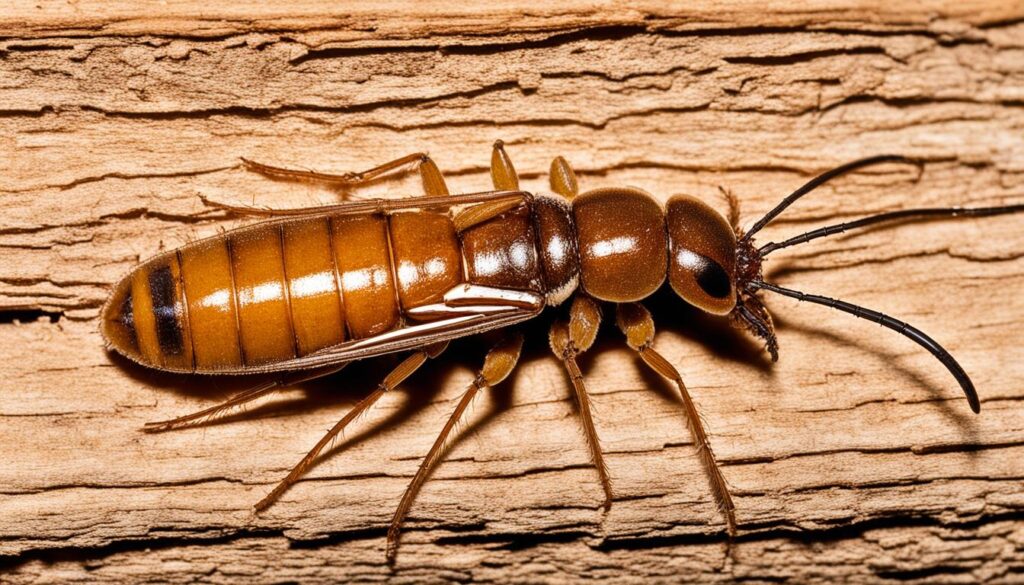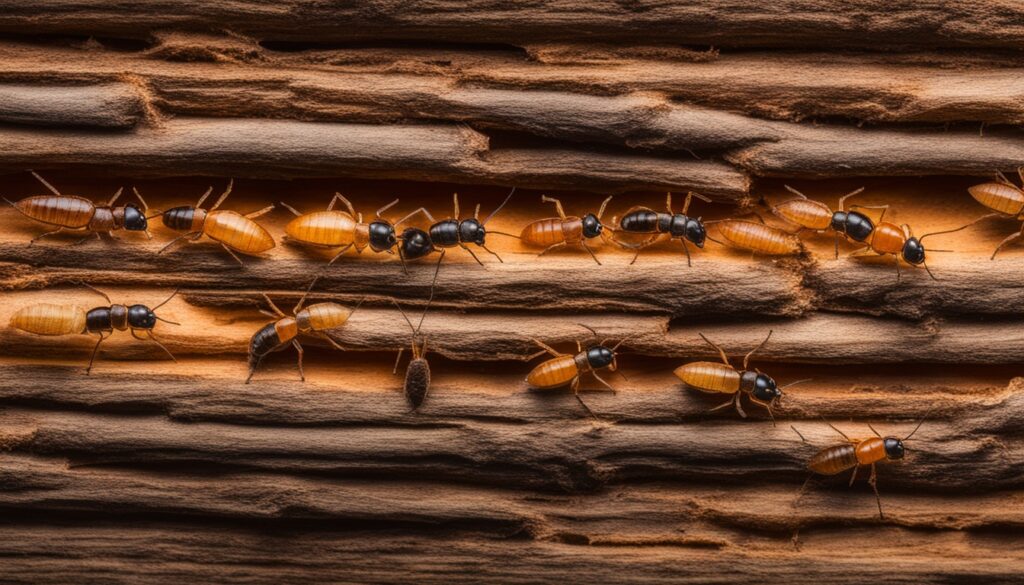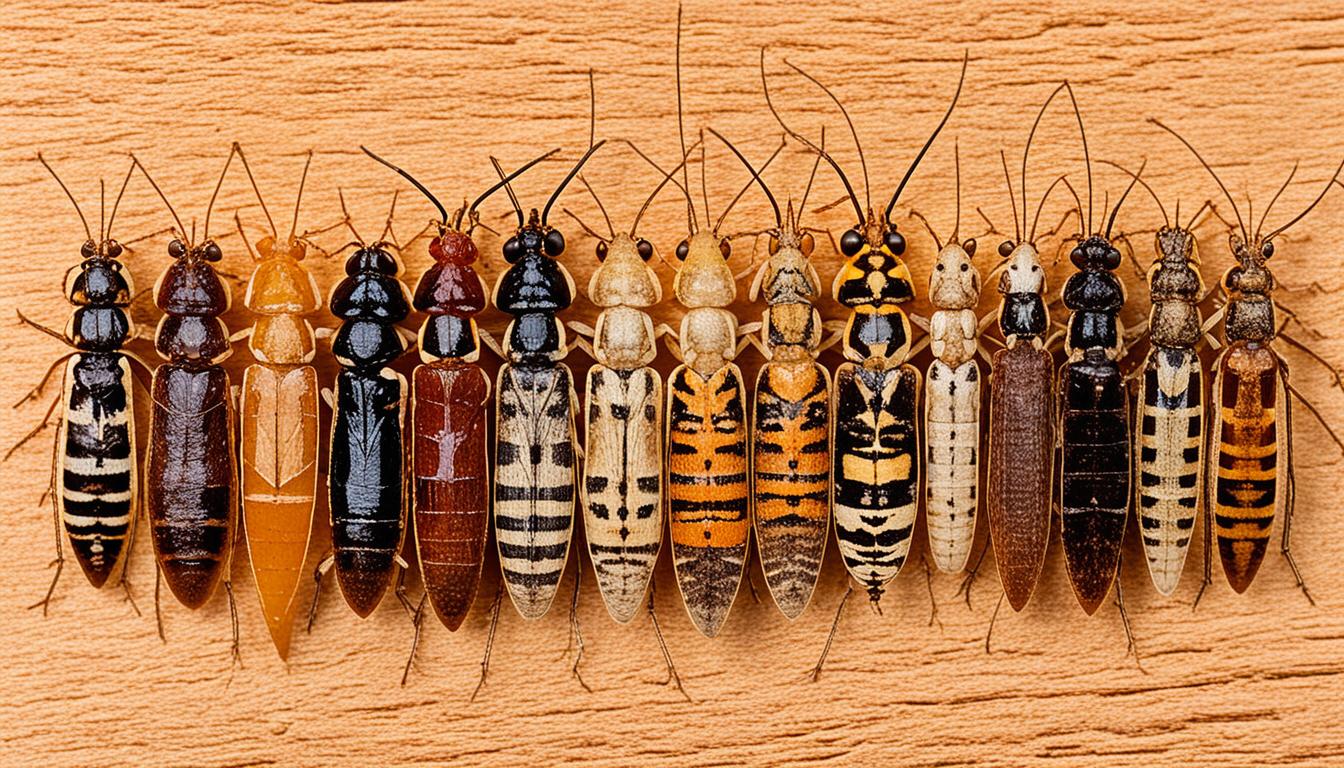Drywood termites (Cryptotermes spp.) have small colonies. They range from a few hundred to a few thousand individuals. Yet, they can cause huge problems in homes and structures. Unlike other termites, they don’t need soil to live. This lets them hide in wood. They can do a lot of damage before you even know they’re there. This guide will help you learn about drywood termites. You’ll find out how to spot them and protect your home from these destructive bugs.
Drywood termites can damage wood without touching the ground. This makes them a big threat to homes in the United States. From Hawaii to the south, they can destroy structures and furniture. It’s important to know about different drywood termite species. This includes what they look like and where they live. This knowledge is key to keeping your home safe from these pests.
Introduction
Drywood termites are a special type of termite. They look different and act in their own way compared to others. There are three main groups among them: the reproductives, workers, and soldiers. The reproductive termites, also called alates, have different colors and wings. These colors can be dark brown or light yellow-tan. The wings are from almost clear to smoky gray and have special veins. They are key in making new colonies.
The soldiers of drywood termites are big and don’t touch the ground. They have big mouths with teeth to protect the colony. The worker termites are small and wingless, ranging from ¼ to 3/8 of an inch. They do important jobs such as finding food, making the nest bigger, and taking care of the others.
Physical Characteristics
Drywood termites have special features that help them live and grow. The reproductives have wings and start new colonies. They have many colors and types of wings, which show the different species. The soldiers are good at defending because of their big mouths and no ground contact. The workers are the smallest group. They look after the nest and feed the others.
Habitats and Geographic Distribution
Drywood termites love eating hard, dry wood inside our houses. They can get the water they need from this wood. So, they don’t even need to touch the ground to live. They are often seen in places like the West Coast, Florida, and Hawaii. If not there, they might be in Texas or the Carolinas. A colony can have up to 2,500 termites. They grow very slowly, needing five years or more to get big. This is because they don’t have many babies, and they have limited space and food.

Drywood Termite Species Names
Cryptotermes
- Cryptotermes brevis
- Cryptotermes cavifrons
- Cryptotermes cynocephalus
- Cryptotermes dudleyi
Incisitermes
- Incisitermes minor
- Incisitermes schwarzi
- Incisitermes snyderi
Kalotermes
- Kalotermes approximatus
- Kalotermes flavicollis
- Kalotermes sinaicus
Neotermes
- Neotermes castaneus
- Neotermes connexus
- Neotermes jouteli
Paraneotermes
- Paraneotermes simplicicornis
Understanding Drywood Termite Species
To know drywood termites, you must know the species in different areas. The main kinds are Incisitermes, Cryptotermes, and Marginitermes. Each type looks different and lives in specific places. This helps in finding them and handling them well.
Incisitermes Species
Incisitermes has dark brown to black color and big, toothed jaws. The western drywood termite (Incisitermes minor) is common in the southwest U.S. It lives in places like southern California, the Pacific Northwest, and Texas. The Incisitermes snyderi is often found in Texas.
Cryptotermes Species
Cryptotermes are brown with bead-like antennas. The Cryptotermes cavifrons lives in the southeast U.S. and islands like the Bahamas and Jamaica.
Marginitermes Species
Marginitermes have a wide pronotum and are smaller. They are not seen as often as the others.
Knowing the traits of each species is key to finding and dealing with them. This knowledge helps pest experts and homeowners handle drywood termites well.
| Genus | Characteristics | Geographic Distribution |
|---|---|---|
| Incisitermes |
|
|
| Cryptotermes |
|
|
| Marginitermes |
|
|

Conclusion
Drywood termites are a big problem for houses and other buildings in the U.S. Knowing about their looks, homes, and types can help. It lets homeowners stop them from ruining their homes. Getting checked by pest control often is smart, and using the right treatment is key.
It’s important to understand what drywood termites leave behind. Things like discarded wings and wood that sounds hollow. Also, spotting their dry, sand-like poop is a clue they’re around. Catching them early and stopping them is vital to keep homes safe.
To really fight these termites, knowing a lot about them is crucial. This helps in making good plans and keeping homes safe. Working with pest control pros and staying on top of things helps a lot. It makes sure homes stay good and don’t get hurt by these sneaky bugs.

